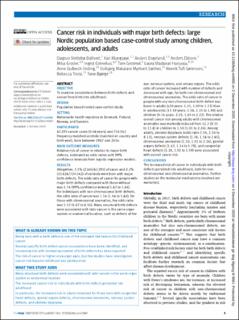| dc.description.abstract | Objective
To examine associations between birth defects and cancer from birth into adulthood.
Design
Population based nested case-control study.
Setting
Nationwide health registries in Denmark, Finland, Norway, and Sweden.
Participants
62 295 cancer cases (0-46 years) and 724 542 frequency matched controls (matched on country and birth year), born between 1967 and 2014.
Main outcome measures
Relative risk of cancer in relation to major birth defects, estimated as odds ratios with 99% confidence intervals from logistic regression models.
Results
Altogether, 3.5% (2160/62 295) of cases and 2.2% (15 826/724 542) of controls were born with major birth defects. The odds ratio of cancer for people with major birth defects compared with those without was 1.74 (99% confidence interval 1.63 to 1.84). For individuals with non-chromosomal birth defects, the odds ratio of cancer was 1.54 (1.44 to 1.64); for those with chromosomal anomalies, the odds ratio was 5.53 (4.67 to 6.54). Many structural birth defects were associated with later cancer in the same organ system or anatomical location, such as defects of the eye, nervous system, and urinary organs. The odds ratio of cancer increased with number of defects and decreased with age, for both non-chromosomal and chromosomal anomalies. The odds ratio of cancer in people with any non-chromosomal birth defect was lower in adults (≥20 years: 1.21, 1.09 to 1.33) than in adolescents (15-19 years: 1.58, 1.31 to 1.90) and children (0-14 years: 2.03, 1.85 to 2.23). The relative overall cancer risk among adults with chromosomal anomalies was markedly reduced from 11.3 (9.35 to 13.8) in children to 1.50 (1.01 to 2.24). Among adults, skeletal dysplasia (odds ratio 3.54, 1.54 to 8.15), nervous system defects (1.76, 1.16 to 2.65), chromosomal anomalies (1.50, 1.01 to 2.24), genital organs defects (1.43, 1.14 to 1.78), and congenital heart defects (1.28, 1.02 to 1.59) were associated with overall cancer risk.
Conclusions
The increased risk of cancer in individuals with birth defects persisted into adulthood, both for non-chromosomal and chromosomal anomalies. Further studies on the molecular mechanisms involved are warranted. | en_US |

